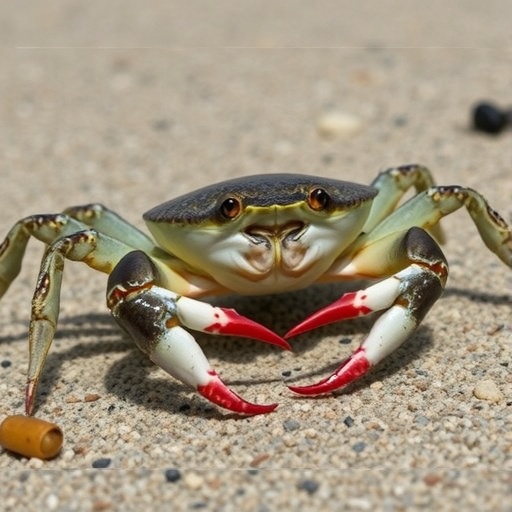A groundbreaking new study conducted by marine biologists at North Carolina State University has shed light on the perplexing population dynamics of blue crabs (Callinectes sapidus) in the Albemarle-Pamlico Estuarine System (APES). This estuary, a crucial nursery and habitat, supports the majority of North Carolina’s blue crab population, which has experienced a stark decline in adult numbers since the early 2000s. The research, however, reveals that juvenile blue crab populations have remained stable both before and after the fishery decline, indicating a previously unrecognized bottleneck in crab life stages that occurs post-nursery lending new complexities to blue crab conservation efforts.
Understanding the life cycle and recruitment patterns of blue crabs is essential for sustainable fisheries management. Mature female crabs release larvae from inlets along the Outer Banks during late spring, where these larvae undergo multiple planktonic molts while drifting in the Atlantic Ocean. By the fall, the juveniles return to the estuarine system aided by wind and storm-driven currents. Upon arrival, young crabs settle into near-shore nursery habitats such as ephemeral seagrass beds dominated by Ruppia maritima and shallow detrital marsh peat mats. These nursery environments provide shelter and foraging opportunities essential for early development.
Erin Voigt, a doctoral candidate leading the study, explains the behavioral transition of juvenile blue crabs within these nursery habitats. Juveniles remain within these protective zones until they achieve sufficient size and strength — indicated by carapace widths ranging between 2.2 and 20 millimeters — to survive predation and competition, at which point they venture into broader estuarine waters. This transition from nursery to adulthood is critical in understanding population resilience and fishery sustainability.
The decline in adult blue crab populations spurred regulatory reforms including a 50% reduction in crab fishing quotas. Despite these protective measures, adult populations have failed to rebound, perplexing fishery managers and scientists alike. Traditionally, such declines have been attributed to recruitment overfishing—overharvesting adults to the extent that insufficient juveniles are produced to sustain the population. This study challenges that assumption by examining juvenile densities directly.
The research involved an extensive comparative analysis of juvenile blue crab densities across three distinct nursery habitats within the APES: patchy western shore seagrass beds, western shallow detrital habitats, and eastern mixed-species seagrass beds, during two time periods spanning pre- (1996–1999) and post-fishery decline (2017–2019). Surprisingly, the data indicated stable densities of juvenile crabs in all habitats over the 20-year gap, with the western seagrass habitats displaying juvenile densities almost four times higher than the traditionally emphasized eastern seagrass beds.
This finding undermines the straightforward narrative of recruitment failure causing adult population declines and suggests alternative ecological or environmental mechanisms at play. Voigt posits that a population bottleneck exists after juveniles leave nursery habitats but before reaching reproductive maturity, a phase that has previously received less research attention. Such bottlenecks could be driven by predation pressures, disease, habitat degradation, or environmental stressors, which may disproportionately impact crabs in this vulnerable life stage.
The study also highlights the dynamic role environmental factors like salinity play in blue crab abundance and catch efficiency. Variability in salinity within the estuary affects the survival and distribution of juvenile crabs, indicating that environmental fluctuations must be integrated into population modeling and fishery assessments to improve accuracy and predictive power.
Moreover, the weak correlation identified between the recruitment of juveniles to adult spawning stock further complicates population management. It suggests that juvenile abundance alone may not adequately predict spawning success, emphasizing the need for holistic approaches that consider multiple life stages and habitat influences in conservation strategies.
The ecological importance of the western shore ephemeral seagrass beds was underscored by their consistently higher juvenile abundance despite their patchy and temporary nature. This paradigm shift in identifying key nursery habitats challenges traditional fishery management plans that had primarily focused on eastern seagrass beds, calling for more nuanced habitat protection policies.
The findings urge marine scientists and resource managers to direct more attention to the poorly understood post-nursery, pre-maturity stages of blue crab development, which appear to be a critical choke point for population recovery. Investigating mortality factors during this life phase is essential for devising effective intervention measures that could reverse adult population declines.
This comprehensive study, published in the September 2025 issue of Fisheries Oceanography, was made possible through funding and support from organizations including North Carolina Sea Grant and the Southeastern Climate Adaptation Science Center. The research team, led by Erin Voigt and Professor David Eggleston, collaborated with former Ph.D. student Lisa Etherington, combining long-term observational data sets with robust ecological analysis to produce these valuable insights.
By illuminating the hidden complexities within blue crab population dynamics in a wind-driven estuary, this research represents a significant advance in marine biology and fisheries science. It sets the stage for transformative conservation strategies that promote sustainable fisheries and the resilience of blue crab populations in the face of environmental and anthropogenic pressures.
Subject of Research: Animals
Article Title: Long-Term Trends in Juvenile Blue Crab Recruitment Patterns in a Wind-Driven Estuary
News Publication Date: 10-Sep-2025
Web References:
https://onlinelibrary.wiley.com/doi/full/10.1111/fog.70009
References: North Carolina State University study published in Fisheries Oceanography, 2025.
Keywords: Fisheries management, Crustaceans, Life cycles
Tags: Albemarle-Pamlico Estuarine Systemblue crab conservation challengesblue crab life cycleblue crab population dynamicsblue crab recruitment patternsCallinectes sapidus declineestuarine nursery environmentsjuvenile blue crab stabilitymarine biology studiesNorth Carolina blue crab researchnursery habitat importancesustainable fisheries management





